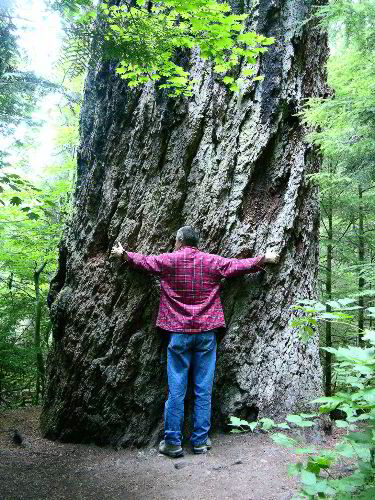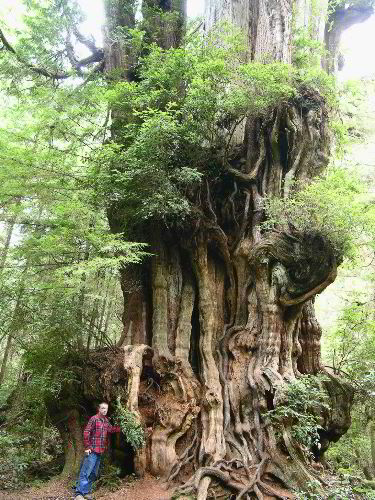|
== 3 of 12 ==
Date: Sun, Nov 16 2008 9:43 am
From: "Edward Frank"
Will,
Excellent account of your trip and adventures in Big Basin Redwoods
State Park. My first encounter with really big trees was a couple
years ago in my 2005 western trip. I did not make it that far south
and have yet to see the redwoods. I had seen some descent sized
trees in North Cascades NP, but nothing really spectacular. I ran
into Seattle to get my tracker fixed, and then headed to Mt. Rainier
NP. I camped at a forest service campground outside the park called
"the Dalles." I wrote a brief note about the encounter at
the time.

"I arrived at the Dalles campsite about 5:30. There were
numerous campsite still available. I picked out one set amongst a
grove of tall trees. I was curious as to how tall they were and got
out my laser rangefinder. The trees were measuring out to be over
200 feet tall. I wasn't sure my instrument was measuring correctly,
because to tell the truth they did not look that tall to me. The
Longfellow Pine at Cook Forest, PA measures 181 feet tall and looked
bigger in my minds eye. There are three predominant species of trees
in the area: Douglas Fir, Western Hemlock, and Red Cedar. The fir
and hemlock were the largest. There was a family in the next
campsite setting up their tents, including a number of teenage boys.
I ask if they could help me lay out a measurement line to check my
instrument. The rangefinder I was reading correctly, trees around
the campsite were over 200 feet tall. I showed them how to use the
instruments and we measured several trees in and adjacent to their
campsite.
One person driving down the campsite road said there was a really
big one down this way. So I walked down. There was a massive Douglas
Fir at the beginning of a short 0.8 mile nature trail. The sign said
the tree was estimated to be 700 years old, was 235 feet tall, and
9' 6" in diameter. Naturally I had to check the measurements.
The best height I could get from the campsite road area was only
around 218 feet, but I knew I was not hitting the top. A short
distance down the trail I managed to find a spot where I could see
the top of the tree. Correcting for the elevation difference between
that point and the base of the tree I con firmed a height for the
tree of 242.1 feet. That is probably accurate to within a foot. I
measured the circumference breast height of the tree to be 31'
11", that converts to a diameter (assuming a round trunk) of
10.16 feet. I was surprised the tree was actually bigger than listed
on the sign. Perhaps it had grown taller since the last measurement.
The difference in diameter could easily be which particular bumps on
the trunk the taped passed across.

I did not find any bigger trees in the area, although down the trail
were several with similar diameters. Within the campground area
itself were at least a dozen trees over 200 feet tall. So for the
day I did get some first impression of Mount Rainier, and see the
biggest tree I have yet seen in my life. I'll take some pictures of
the big tree and the sign in the morning when there is more light.
Not bad for a day devoted to maintenance."

Kalaloch Cedar
The next few days found me visiting Mt. Rainier and Olympic National
Parks. Some of these are described in Bob Van Pelt's Forest Giants
of the pacific Coast. The trees encounters included the Kalaloch Red
Cedar in Olympic National Park This was once the National Champion
western red cedar at 19.6 ft diameter, and 123 feet tall.
Interestingly I had a photo of the tree on my laptop at one of the
Forest Summit meetings. I was sitting at Monica;s kitchen table one
morning and Jess Riddle immediately recognized the tree, shot from
the back side based just upon photos he has seen of it. Another
named tree was the Queets Sitka Spruce at 14, 9 ft diameter, and 245
feet tall. In the Hoh Rain Forest itself were Douglas firs in the
280 range. What struck me was how you had to change your perspective
on estimating heights when visiting these extremely tall trees. As
for the canopy species diversity, Bob Van Pelt commented in a post
dated October 29, 2002, "The low diversity of trees in some
Western forests quickly reduces the Index to below 200. Humboldt
Redwoods SP, for example, has the world's tallest tree, and 86 trees
over 350'. Due to the overwhelming dominance by redwood, the Index
drops below 200 after only six species are included!" That was
one of the reasons I was arguing for compiling the RI5 for a minimal
species comparison for various sites, to deal fairly with sites with
a low canopy species diversity.
Sounds like it was a great trip. I hope it gets you psyched for more
eastern tree research as well. The first encounter with these giant
trees is really something hard to describe.
Ed Frank
== 4 of 12 ==
Date: Sun, Nov 16 2008 9:53 am
From: "Will Blozan"
Ed,
Awesome! Man, you gotta love those Dougies!
Will F. Blozan
President, Eastern Native Tree Society
President, Appalachian Arborists, Inc.
|